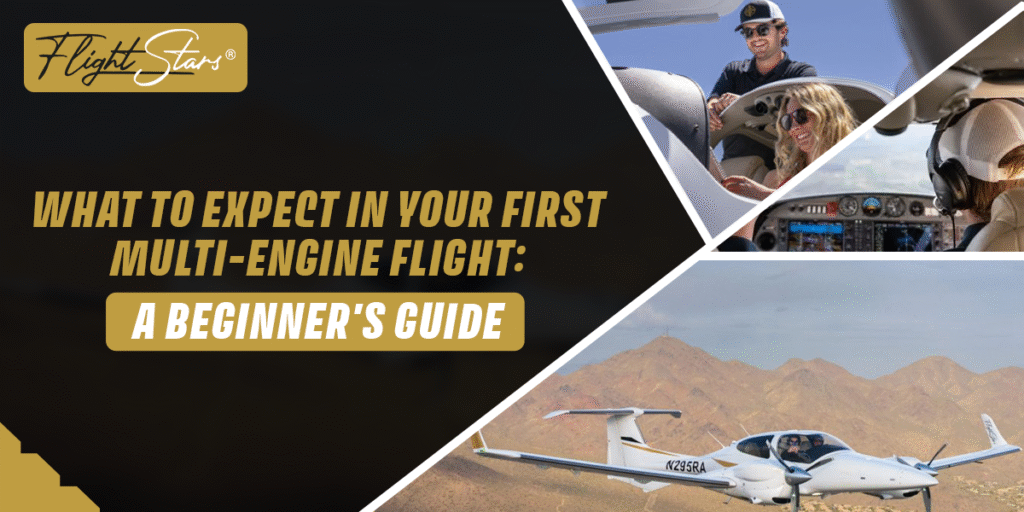Flying an aircraft for the first time can be an exciting experience. If you have already flown a single-engine aircraft, a multi-engine flight will feel a bit different. This beginner’s guide helps you understand what to expect during your first multi-engine flight and how this flight training can make you a confident pilot.
Understanding the Multi-Engine Aircraft
What is a Multi-Engine Aircraft?
A multi-engine aircraft has two or more engines, which give added reliability and power. These aircraft are designed to handle long distances and carry more passengers or cargo. The added engine power allows the aircraft to maintain flight even if one engine fails, which is a key difference from a single-engine plane.
Few points that set this aircraft apart:
- Increased power: With more engines, the aircraft can fly faster and carry heavier loads.
- Safety advantages: In case of an engine failure, the remaining engine provides a backup to keep the aircraft in the air.
- Longer range: These aircrafts are built for longer flights, especially in commercial aviation, where distance and time are important.
The Importance of Multi-Engine Training Period
Flying an aircraft is more complex than flying a single-engine plane. Multi-engine flight training is important because it teaches you how to operate these more powerful machines, handles engine failures, and manage both engines during flight.
Why is Multi-Engine Training so Important?
- Engine management: You will learn how to control two engines, making sure both are performing optimally throughout the flight.
- Emergency procedure: You will practice engine-out procedure and learn what to do if one engine fails while in flight.
- Confidence and skill: With proper training, you will become confident in handling the aircraft, even in challenging conditions.
What to Expect in Your First Multi-Engine Flight?
Pre-Flight Preparation
Before taking off, a thorough pre-flight checklist is important. This checklist makes sure everything is in proper working order, from the engines to the instruments. While the checklist may seem long, it is an important part of your flight routine.
What You Will Typically Do During Pre-Flight?
- Inspect the aircraft: Make sure all safety equipment is in place, check the fuel levels, and make sure the engines are in good condition.
- Review the Pilot Checklist: Your instructor will walk you through the checklist to confirm that everything is ready for takeoff.
This preparation makes sure a safe flight and sets the stage for what’s to come during your multi-engine flight.
Your First Takeoff and Flight
The first time you take off, you will notice several key differences compared to single-engine flights. The multi-engine aircraft will accelerate faster because it has more power, and you will feel a greater sense of stability once you are airborne.
What You Should Expect During Your First Flight?
- Faster acceleration: The aircraft will take off more quickly, which may feel exciting but manageable with proper training.
- Smooth climb: Once in the air, the climb will be faster and smoother due to the additional engine power.
- Balanced flight: You will need to pay attention to how both engines are performing and make sure the aircraft remains balanced throughout.
As you become more familiar with the aircraft, you will feel more at ease during each phrase of the flight.
Handling Engine-Out Procedures
One of the most important aspects of flight training is learning how to handle engine-out procedures. This is when one engine stops working during flight. It is an important skill for multi-engine pilots, as knowing how to handle a single-engine situation can make all the differences in an emergency.
During Your Training, You Will Practice the Following:
- Maintain control: Learn how to keep the aircraft steady with one engine operating while the other is out.
- Determine the best course of action: You will need to choose the best path to land the plane safely. This might involve heading toward an airport or a clear area to make an emergency landing.
By practicing these scenarios, you will become more confident in your ability to handle any situation.
The Role of Your Flight Instructor
Your flight instructor kicks to an important role during your first multi-engine flight. They will guide you through each step of the training, helping you understand the aircraft’s systems, manage the engines, and handle emergencies.
What to Expect from Your Instructor?
- Safety first: Your instructor will focus on your safety and make sure you understand each procedure before attempting it on your own.
- Hands-on guidance: During the flight, they will help you manage both engines, check your controls, and make sure you are comfortable with the aircraft.
- Confidence-building: The instructor’s job is to build your confidence and help you feel at ease in the cockpit. They will answer any questions you have and offer tips for improvement.
With the right instructor, your first multi-engine flight will feel much more manageable and enjoyable.
Benefits of a Multi-Engine Rating
Career Opportunities
For pilots who want to fly professionally, obtaining a multi-engine is a crucial step. Many commercial airlines and private aviation companies require pilots to have a multi-engine rating to operate larger aircraft.
The Career Benefits of Obtaining a Multi-Engine Rating:
- Access to more aircraft: This engine rating allows you to operate a variety of aircraft that require more than one engine.
- Job flexibility: With a rating system, you will have more career opportunities, including commercial aviation, charter flights, and flight schools.
- Better pay: Many jobs requiring a multi-engine rating provide higher pay and more advanced benefits.
Improved Flight Performance
Beyond career opportunities, it also improves your flying skills. Flying this aircraft gives you experience with more powerful engines, better fuel efficiency, and the ability to handle more challenging weather conditions.
How Does This Rating Engine Improve Your Flying?
- Higher performance: Multi–engine aircraft are faster and more powerful, making them better suited for long-distance flights.
- Better handling: You will gain better control of the aircraft, especially when one engine fails or you are in challenging weather.
- Increased safety: Having a proper rating gives you the skills to handle any emergency situations that may arise during flight.
Conclusion
Your first multi-engine flight will be an exciting and rewarding experience. With proper training and guidance from your instructor, you will quickly become confident in managing both engines and handling any emergency situations.
At Go Flight Stars, we are committed to helping you achieve your aviation goals, if you are just starting out or looking to expand your skills with an engine rating.
Frequently Asked Questions on Your First Multi‑Engine Flight:
Q1: What is the difference between a multi-engine aircraft and a single-engine aircraft?
A1: A multi-engine aircraft has two or more engines, making it more powerful and comparable to single engine planes. It can fly longer distances and carry more weight, while also providing better safety features in case of engine failure.
Q2: How long does it take to get an average engine rating?
A2: On average, it takes 50 hours of flight training to earn an engine rating, along with ground school to understand the aircraft’s systems and procedures. The exact time may vary based on prior experience.
Q3: What careers require an engine rating?
A3: A multi-engine rating, required for commercial aviation jobs, including airline pilots, corporate pilots, and instructors. It also opens up job opportunities in industries that use it in larger terms.





